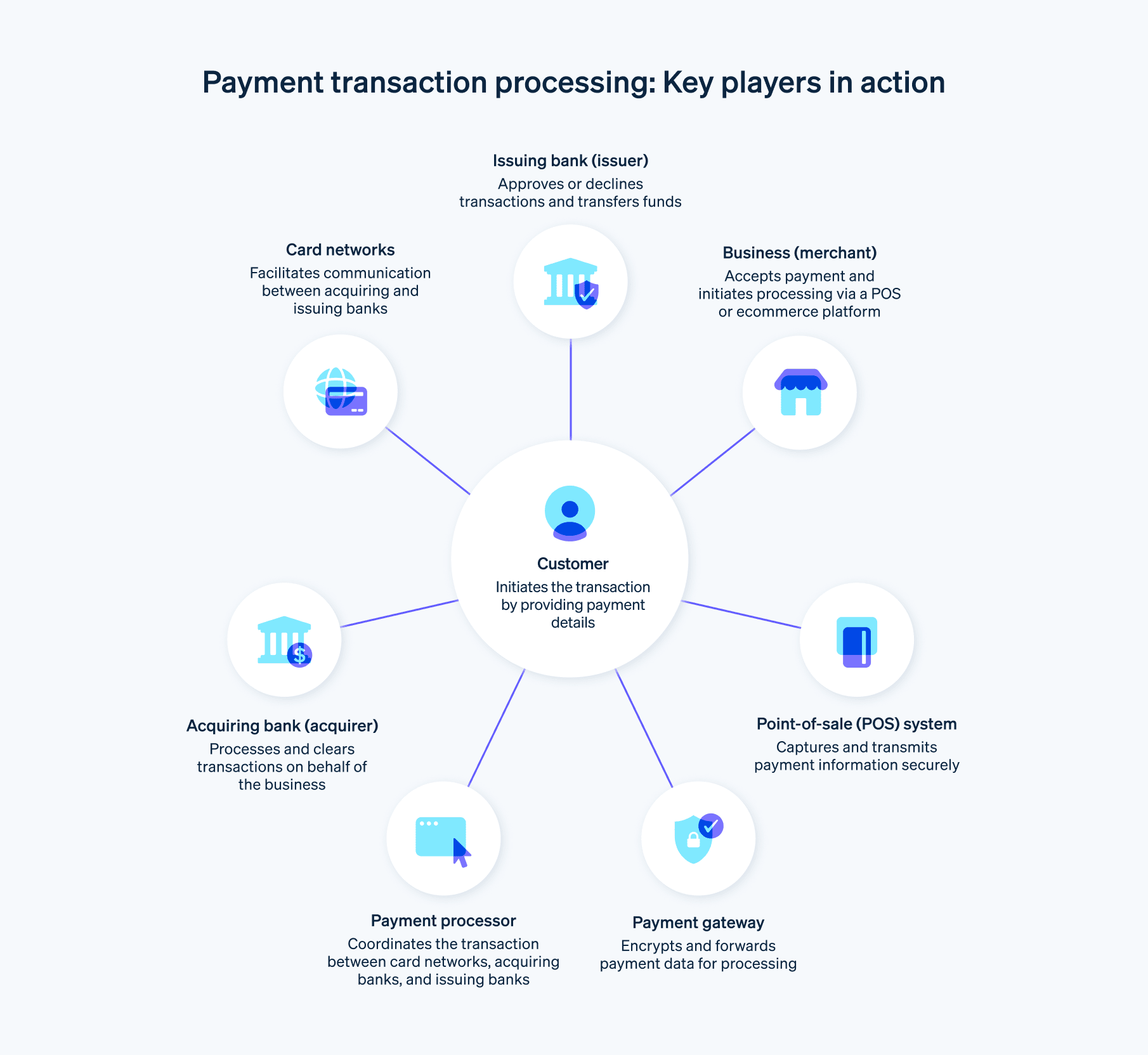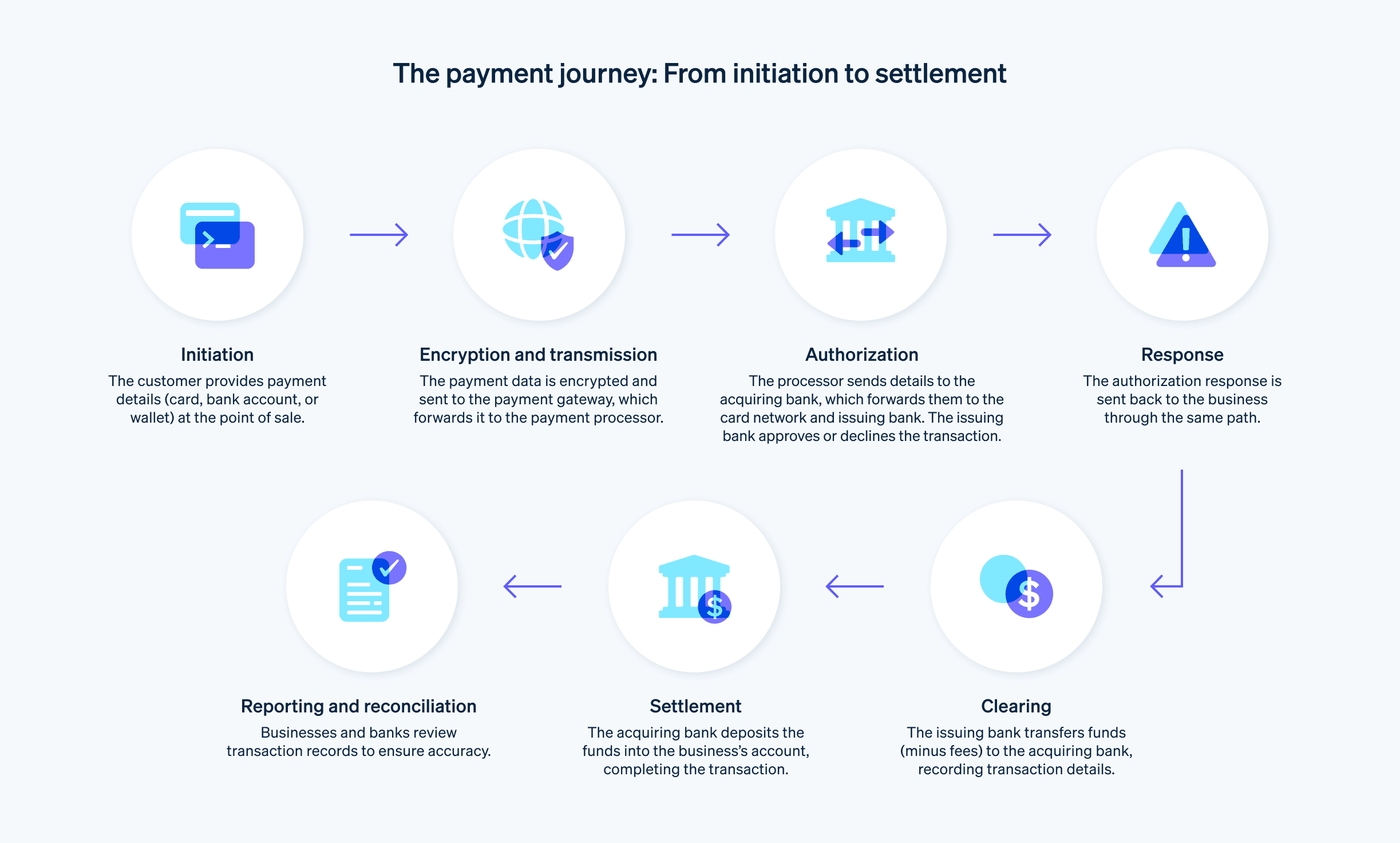Med hjälp av en rad digitala verktyg, system och plattformar kan företag nu nå kunder via onlinebutiker, mobila betalningsplattformar och sociala medier. Behandling av betalningstransaktioner har anpassat sig till utvecklingen för att tillgodose kundernas ständigt föränderliga behov och deras betalningspreferenser.
I takt med att digitala betalningstransaktioner fortsätter att växa i antal bör företag förstå hur uppdaterade betalningshanteringssystem kan hjälpa dem att förbli konkurrenskraftiga. I den här artikeln tar vi upp de viktigaste aspekterna av behandling av betalningstransaktioner, de inblandade parterna och komponenterna samt användbara insikter som hjälper företag genom utmaningarna som digital handel innebär.
Vad innehåller den här artikeln?
- Vad är betalningsbehandling?
- Behandling av betalningstransaktioner: Nyckelaktörer och komponenter
- Hur fungerar behandling av betalningstransaktioner?
- Varför är det viktigt för företag att behandla betalningstransaktioner?
Vad är betalningsbehandling?
Betalningsbehandling är det sätt på vilket köpare och säljare hanterar finansiella transaktioner. Den består av många steg och involverar auktorisering, clearing och avräkning av transaktioner.
Behandling av betalningstransaktioner: Nyckelaktörer och komponenter
Behandlingen av betalningstransaktioner är ett komplext system som involverar flera aktörer och komponenter som samverkar för att möjliggöra säker och effektiv överföring av medel vid finansiella transaktioner. Här följer en översikt över de parter som är involverade i betalningstransaktioner:

Kortinnehavare
Kortinnehavaren är den fysiska eller juridiska person som initierar betalningen genom att tillhandahålla sina betalningsuppgifter (kreditkorts-, bankkorts- eller bankkontouppgifter) för ett köp eller en tjänst.Företag
Företaget är den handlare, butik eller tjänsteleverantör som tar emot betalningen från kunden i utbyte mot varor eller tjänster.Inlösande bank eller inlösare
Den inlösande banken, eller inlösaren, är det finansinstitut som innehar handlarkontot och tar emot transaktionsinformationen från betalleverantören. Den inlösande banken ansvarar för auktorisering, clearing och avräkning av transaktioner.Utfärdande bank eller utfärdare
Den utfärdande banken eller utfärdaren är det finansinstitut som utfärdade kredit- eller bankkortet till kunden. Den utfärdande banken validerar kundens tillgängliga medel eller kredit och godkänner eller avvisar transaktionen.Kortnätverk
Kortbetalningsnätverk är organisationer som Visa, Mastercard, American Express och Discover som etablerar infrastrukturen och riktlinjerna för behandling av kreditkortstransaktioner. Kortbetalningsnätverk fungerar som en kanal mellan inlösande banker och utfärdande banker, vilket säkerställer smidig kommunikation, auktorisering och betalning av transaktioner.Betalningsnätsluss
En betalningsnätsluss är ett verktyg som på ett säkert sätt överför betalningsdata från företagets kassasystem eller e-handelsplattform till den inlösande banken för behandling. Den krypterar kortinnehavarens information och verifierar att transaktionen följer säkerhetsstandarder.Betalleverantör
En betalleverantör eller betaltjänst, är ett företag som övervakar transaktionsprocessen på uppdrag av den inlösande banken. En betaltjänsts ansvarsområden omfattar uppgifter som att kommunicera med betalningsnätverk, skaffa auktoriseringar och hantera avräkningsprocessen.POS-system
Kassasystemet är det fysiska eller digitala gränssnittet där kundens betalningsinformation samlas in och överförs för behandling. I fysiska butiker kan detta inkludera kortterminaler eller mobila betalningsenheter, medan det i den digitala världen inbegriper e-handelsplattformar, mobilappar eller webbplatser.
Dessa parter arbetar tillsammans för att garantera att kreditkortstransaktioner är säkra, effektiva och efterlever regler och branschstandarder, vilket säkerställer en sömlös och snabb betalningsupplevelse för både kunder och företag.
Hur fungerar behandling av betalningstransaktioner?
Behandling av betalningstransaktioner är en rad steg som utförs när en kund initierar en finansiell transaktion med ett företag, vanligtvis för inköp av varor eller tjänster. Processen omfattar flera enheter och komponenter som samverkar för att på ett säkert och effektivt sätt auktorisera och avräkna transaktionen. Processen kan se olika ut beroende på faktorer som:
- Betalningsmiljö (fysisk, online eller mobil)
- Betalningskanal (webbplats, mobilapp, fysisk butik, mobil återförsäljare, leverantör av hemtjänst osv.)
- Betalningsmetod (kredit- eller bankkort, banköverföring, digital plånbok, etc.)
Trots dessa skillnader är den allmänna processen likartad. Här är en steg-för-steg-översikt:

Initiering
Kunden tillhandahåller sina betalningsuppgifter, som kortnummer eller bankkontouppgifter, i företagets kassasystem, kortterminal eller e-handelskassa.Kryptering och överföring
Betalningsinformationen överförs på ett säkert sätt till en betalningsnätsluss, som krypterar data och vidarebefordrar den till betalleverantören.Auktorisering
Betalleverantören skickar transaktionsuppgifterna till den inlösande banken (företagets bank), som vidarebefordrar informationen till den utfärdande banken (kundens bank) via det relevanta kortbetalningsnätverket. Den utfärdande banken verifierar kundens konto och kontrollerar att det finns tillräckliga medel eller kredit för att genomföra transaktionen. Vid denna tidpunkt skickar den utfärdande banken ett meddelande om godkännande eller avslag via kortbetalningsnätverken och den inlösande banken till betalleverantören.Svar
Betalningsprocessorn vidarebefordrar transaktionens godkännande- eller avslagsstatus till företaget, som sedan informerar kunden om resultatet. Om transaktionen godkänns kan företaget gå vidare och tillhandahålla varorna eller tjänsterna. Om transaktionen nekas får företaget en kod för nekad betalning, som anger varför transaktionen inte kunde godkännas, och de meddelar kunden.Clearing
När transaktionen har auktoriserats börjar clearingprocessen. Den utfärdande banken överför transaktionsbeloppet (minus eventuella avgifter) till den inlösande banken via kortbetalningsnätverken. Uppgifterna registreras och stäms av mellan de inblandade parterna.Avräkning
Under betalningsprocessen sätter den inlösande banken in pengarna på företagets konto. Företaget tar emot betalningen och transaktionen anses därmed vara slutförd.Rapportering och avstämning
Företaget och finansinstituten granskar och stämmer av sina transaktionsposter för att säkerställa att de är korrekta och åtgärdar eventuella avvikelser.
Varför är det viktigt för företag att behandla betalningstransaktioner?
Behandling av betalningstransaktioner är viktigt för företag av flera skäl:
Bekvämt för kunden
Betalningsbehandling spelar en viktig roll för företag i syfte att forma kundupplevelsen. När kunder handlar eller använder en tjänst förväntar de sig en smidig och problemfri betalningsprocess. Genom att erbjuda effektiva och användarvänliga betalningsalternativ och ta emot en rad olika elektroniska betalningsmetoder kan företag se till att deras kunder får en positiv upplevelse, vilket i sin tur bygger förtroende och lojalitet.Utökade försäljningsmöjligheter
Genom att ta emot elektroniska betalningar kan företag nå en bredare kundbas – inklusive kunder som föredrar kontantlösa transaktioner, nätshoppare och internationella kunder – vilket kan leda till ökad försäljning och ökade intäkter.Förbättrat kassaflöde
Elektroniska betalningar behandlas och avräknas vanligtvis snabbare än traditionella metoder, såsom checkar. Detta hjälper företag att upprätthålla ett stabilt kassaflöde, vilket är viktigt för att täcka driftskostnader och stödja tillväxt.Förbättrad säkerhet
System för behandling av betalningstransaktioner använder avancerade säkerhetsåtgärder, t.ex. kryptering och identifiering av bedrägeri, för att skydda känsliga uppgifter och minimera risken för obehöriga transaktioner.Förenklad registerföring
Elektroniska betalningsbehandlingssystem genererar automatiskt transaktionsposter, vilket minskar arbetsbelastningen med att hålla koll på försäljning, hantera lager och övervaka ekonomiska resultat.Färre mänskliga fel
Automatiserad betalningsbehandling minimerar den ständigt närvarande risken för mänskliga fel i samband med manuell hantering av kontant- eller checktransaktioner, vilket säkerställer större noggrannhet i den ekonomiska förvaltningen.Efterlevnad av regelverk
Betalleverantörer hjälper företag att följa branschens regler och standarder, till exempel Payment Card Industry Data Security Standard (PCI DSS), som reglerar hanteringen av kortinnehavarens information.Skalbarhet
I takt med att företag växer kan elektroniska betalningsbehandlingssystem enkelt skalas upp för att hantera högre transaktionsvolymer, vilket säkerställer fortsatt effektivitet och tillförlitlighet.
Behandling av betalningstransaktioner kan verka som en enkel teknisk lösning för företag som behöver kunna ta emot betalningar från kunder. Men som är fallet med många aspekter av att bygga och driva ett företag är det mycket mer komplicerat än det ser ut.
Att arbeta med en enastående leverantör inom det här området är ett smart sätt att minska en del av komplexiteten och skapa ett system med lösningar som passar dina behov och mål – och att upprätthålla en konkurrenskraftig kundupplevelse som är säker, effektiv och efterlever alla regler. För att lära dig mer om hur Stripe tar sig an denna utmaning för företag kan du komma igång här.
Innehållet i den här artikeln är endast avsett för allmän information och utbildningsändamål och ska inte tolkas som juridisk eller skatterelaterad rådgivning. Stripe garanterar inte att informationen i artikeln är korrekt, fullständig, adekvat eller aktuell. Du bör söka råd från en kompetent advokat eller revisor som är licensierad att praktisera i din jurisdiktion för råd om din specifika situation.